key Alfa Romeo 4C 2015 Owner handbook (in English)
[x] Cancel search | Manufacturer: ALFA ROMEO, Model Year: 2015, Model line: 4C, Model: Alfa Romeo 4C 2015Pages: 199, PDF Size: 7.67 MB
Page 114 of 199
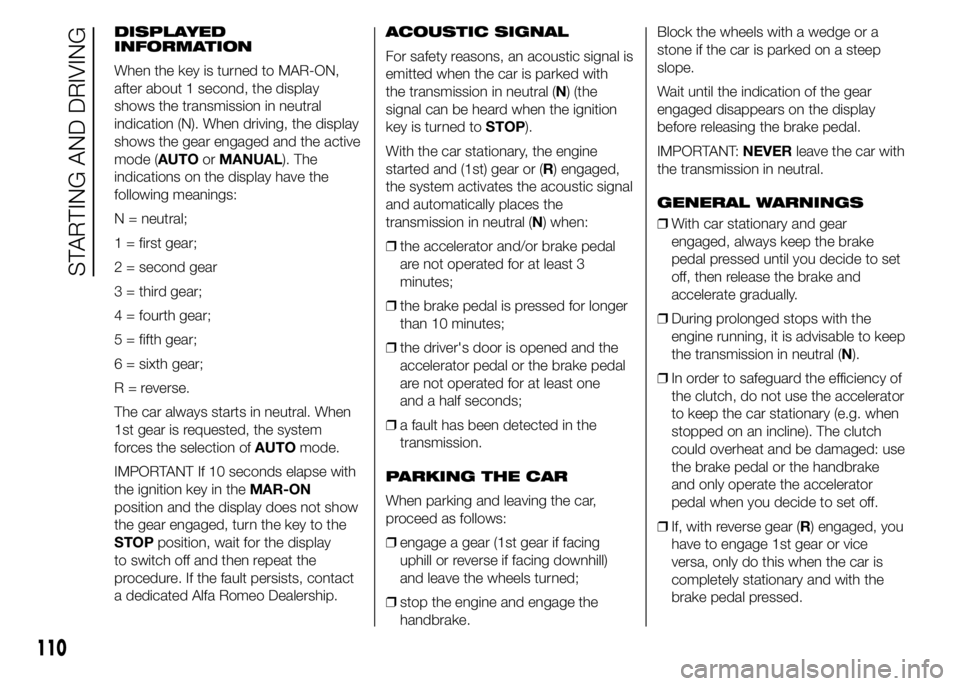
DISPLAYED
INFORMATION
When the key is turned to MAR-ON,
after about 1 second, the display
shows the transmission in neutral
indication (N). When driving, the display
shows the gear engaged and the active
mode (AUTOorMANUAL). The
indications on the display have the
following meanings:
N = neutral;
1 = first gear;
2 = second gear
3 = third gear;
4 = fourth gear;
5 = fifth gear;
6 = sixth gear;
R = reverse.
The car always starts in neutral. When
1st gear is requested, the system
forces the selection ofAUTOmode.
IMPORTANT If 10 seconds elapse with
the ignition key in theMAR-ON
position and the display does not show
the gear engaged, turn the key to the
STOPposition, wait for the display
to switch off and then repeat the
procedure. If the fault persists, contact
a dedicated Alfa Romeo Dealership.ACOUSTIC SIGNAL
For safety reasons, an acoustic signal is
emitted when the car is parked with
the transmission in neutral (N) (the
signal can be heard when the ignition
key is turned toSTOP).
With the car stationary, the engine
started and (1st) gear or (R) engaged,
the system activates the acoustic signal
and automatically places the
transmission in neutral (N) when:
❒the accelerator and/or brake pedal
are not operated for at least 3
minutes;
❒the brake pedal is pressed for longer
than 10 minutes;
❒the driver's door is opened and the
accelerator pedal or the brake pedal
are not operated for at least one
and a half seconds;
❒a fault has been detected in the
transmission.
PARKING THE CAR
When parking and leaving the car,
proceed as follows:
❒engage a gear (1st gear if facing
uphill or reverse if facing downhill)
and leave the wheels turned;
❒stop the engine and engage the
handbrake.Block the wheels with a wedge or a
stone if the car is parked on a steep
slope.
Wait until the indication of the gear
engaged disappears on the display
before releasing the brake pedal.
IMPORTANT:NEVERleave the car with
the transmission in neutral.
GENERAL WARNINGS
❒With car stationary and gear
engaged, always keep the brake
pedal pressed until you decide to set
off, then release the brake and
accelerate gradually.
❒During prolonged stops with the
engine running, it is advisable to keep
the transmission in neutral (N).
❒In order to safeguard the efficiency of
the clutch, do not use the accelerator
to keep the car stationary (e.g. when
stopped on an incline). The clutch
could overheat and be damaged: use
the brake pedal or the handbrake
and only operate the accelerator
pedal when you decide to set off.
❒If, with reverse gear (R) engaged, you
have to engage 1st gear or vice
versa, only do this when the car is
completely stationary and with the
brake pedal pressed.
110
STARTING AND DRIVING
Page 115 of 199
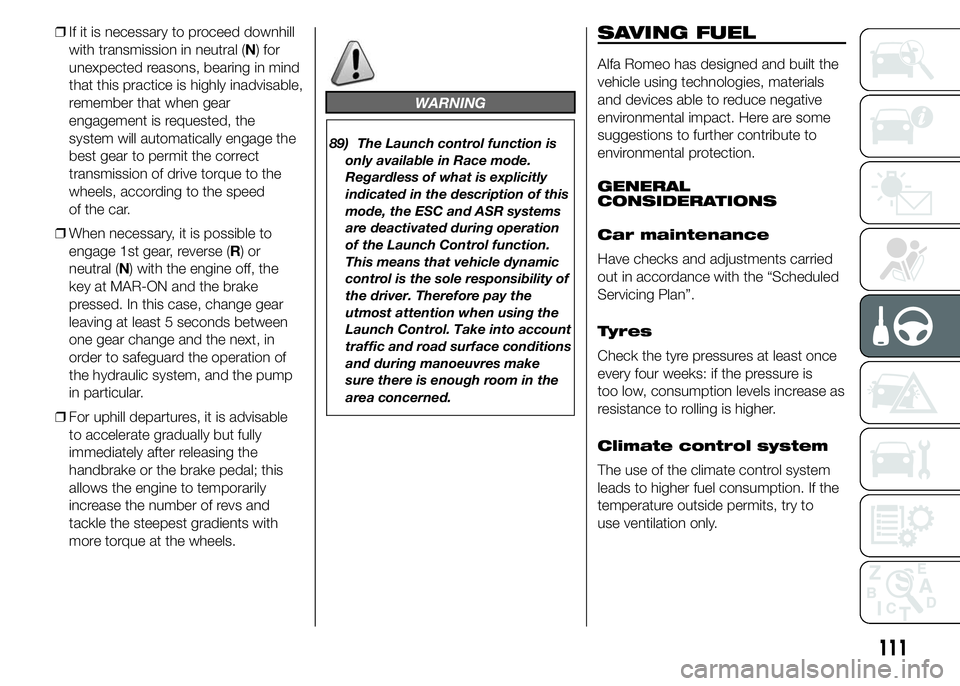
❒If it is necessary to proceed downhill
with transmission in neutral (N) for
unexpected reasons, bearing in mind
that this practice is highly inadvisable,
remember that when gear
engagement is requested, the
system will automatically engage the
best gear to permit the correct
transmission of drive torque to the
wheels, according to the speed
of the car.
❒When necessary, it is possible to
engage 1st gear, reverse (R)or
neutral (N) with the engine off, the
key at MAR-ON and the brake
pressed. In this case, change gear
leaving at least 5 seconds between
one gear change and the next, in
order to safeguard the operation of
the hydraulic system, and the pump
in particular.
❒For uphill departures, it is advisable
to accelerate gradually but fully
immediately after releasing the
handbrake or the brake pedal; this
allows the engine to temporarily
increase the number of revs and
tackle the steepest gradients with
more torque at the wheels.
WARNING
89) The Launch control function is
only available in Race mode.
Regardless of what is explicitly
indicated in the description of this
mode, the ESC and ASR systems
are deactivated during operation
of the Launch Control function.
This means that vehicle dynamic
control is the sole responsibility of
the driver. Therefore pay the
utmost attention when using the
Launch Control. Take into account
traffic and road surface conditions
and during manoeuvres make
sure there is enough room in the
area concerned.
SAVING FUEL
Alfa Romeo has designed and built the
vehicle using technologies, materials
and devices able to reduce negative
environmental impact. Here are some
suggestions to further contribute to
environmental protection.
GENERAL
CONSIDERATIONS
Car maintenance
Have checks and adjustments carried
out in accordance with the “Scheduled
Servicing Plan”.
Tyres
Check the tyre pressures at least once
every four weeks: if the pressure is
too low, consumption levels increase as
resistance to rolling is higher.
Climate control system
The use of the climate control system
leads to higher fuel consumption. If the
temperature outside permits, try to
use ventilation only.
111
Page 119 of 199

❒ensure that the air intake directly in
front of the windscreen is not
obstructed by leaves or other foreign
bodies; any leaves in the air intake
could reduce the air flow and, if they
enter the reservoir, could prevent
water drainage. In winter months,
make sure that the air intake is not
obstructed by ice, mud or snow.
IMPORTANT After turning the ignition
key to STOP and having closed the
driver side door, wait at least one
minute before disconnecting the
electrical supply from the battery. When
reconnecting the electrical supply to
the battery, make sure that the ignition
key is in the STOP position and the
driver side door is closed.
115
Page 138 of 199
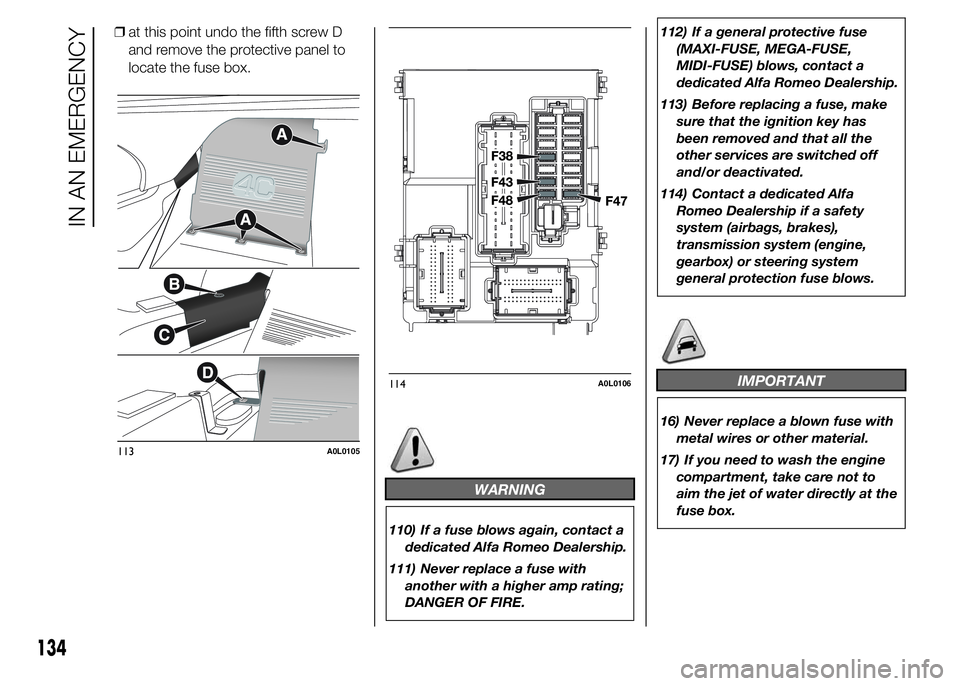
❒at this point undo the fifth screw D
and remove the protective panel to
locate the fuse box.
WARNING
110) If a fuse blows again, contact a
dedicated Alfa Romeo Dealership.
111) Never replace a fuse with
another with a higher amp rating;
DANGER OF FIRE.112) If a general protective fuse
(MAXI-FUSE, MEGA-FUSE,
MIDI-FUSE) blows, contact a
dedicated Alfa Romeo Dealership.
113) Before replacing a fuse, make
sure that the ignition key has
been removed and that all the
other services are switched off
and/or deactivated.
114) Contact a dedicated Alfa
Romeo Dealership if a safety
system (airbags, brakes),
transmission system (engine,
gearbox) or steering system
general protection fuse blows.
IMPORTANT
16) Never replace a blown fuse with
metal wires or other material.
17) If you need to wash the engine
compartment, take care not to
aim the jet of water directly at the
fuse box.
113A0L0105
114A0L0106
134
IN AN EMERGENCY
Page 140 of 199

RECHARGING THE
BATTERY
IMPORTANT The battery recharging
procedure is given as information only.
To carry out this operation contact
the dedicated Alfa Romeo Dealership.
IMPORTANT After turning the ignition
key to STOP and having closed the
driver side door, wait at least one
minute before disconnecting the
electrical supply from the battery. When
reconnecting the electrical supply to
the battery, make sure that the ignition
key is in the STOP position and the
driver side door is closed.
We advise you to use a battery charger
with rated recharging voltage of 12 V
and maximum current 15 A, for a
period from 12–24 hours. Charging for
a longer time may damage the battery.
To recharge, proceed as follows:
❒disconnect the negative battery
terminal;
❒connect the charger cables to the
battery terminals, observing the
polarity;
❒turn on the charger;❒when it is recharged, turn the charger
off before disconnecting it from the
battery;
❒reconnect the negative battery
terminal.
RAISING THE CAR
If raising the car is necessary, contact a
dedicated Alfa Romeo Dealership,
who will be equipped with suitable arm
or workshop lifts, in addition to the
specific equipment necessary.
It is however possible to use suitable
lowered hydraulic jacks to raise the car
if necessary.
The car lifting points are marked on the
side skirts with the
symbols (see
points illustrated in fig. 115).
The correct support points for raising
the front and rear part of the car are
illustrated in fig. 116 and fig. 117.
115A0L0029
136
IN AN EMERGENCY
Page 142 of 199

WARNING
115) Before towing, turn the ignition
key to MAR-ON and then to STOP
without removing it. The steering
column will automatically lock
when the key is removed and the
wheels cannot be steered. Also
check that the gearbox/
transmission is in neutral (N).
116) When towing, remember that
the assistance of the brake servo
is absent. Consequently, more
force is required at the pedal
in order to brake. Do not
use flexible cables when towing
and avoid jerky movements. Make
sure not to damage parts in
contact with the car while towing.
When towing the car, you must
comply with all specific traffic
regulations, both in terms of the
towing device and behaviour
on the road. Do not start the
engine while towing the car.
Before tightening the ring, clean
the threaded housing thoroughly.
Make sure that the ring is fully
screwed into the housing before
towing the car.117) The tow hook must be used
exclusively for roadside
assistance operations. You are
allowed to tow the vehicle for
short distances using an
appropriate device in accordance
with the highway code (a rigid
bar), to move the vehicle on the
road in readiness for towing or
transport via a breakdown vehicle.
Tow hooks MUST NOT be used
to tow vehicles off the road or
where there are obstacles and/or
for towing operations using cables
or other non-rigid devices. In
compliance with the above
conditions, towing must take
place with the two vehicles (one
towing, the other towed) aligned
as much as possible along the
same centre line.
138
IN AN EMERGENCY
Page 156 of 199
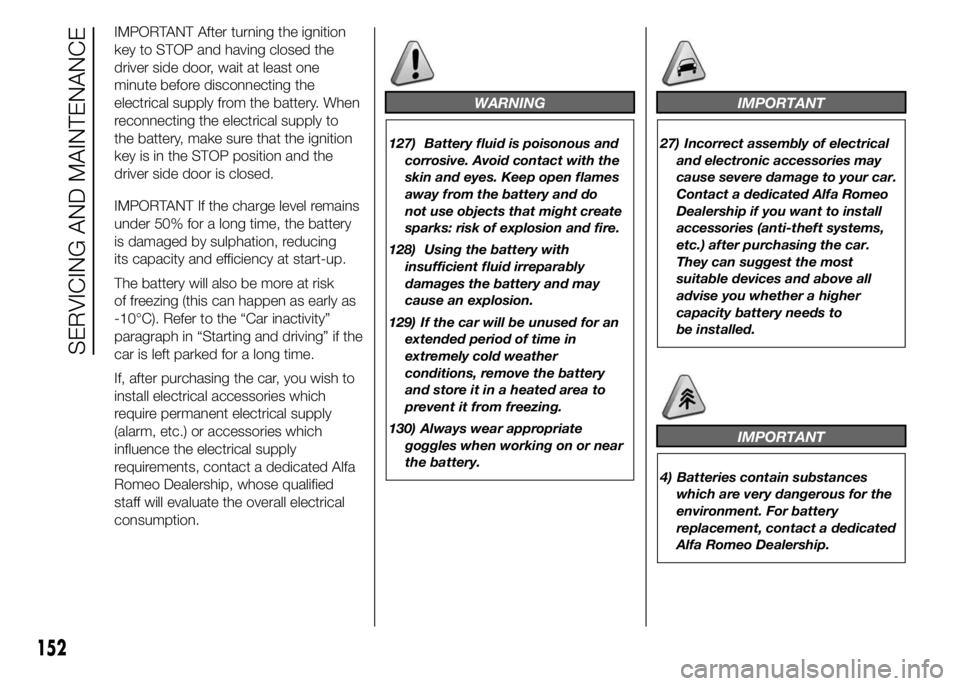
IMPORTANT After turning the ignition
key to STOP and having closed the
driver side door, wait at least one
minute before disconnecting the
electrical supply from the battery. When
reconnecting the electrical supply to
the battery, make sure that the ignition
key is in the STOP position and the
driver side door is closed.
IMPORTANT If the charge level remains
under 50% for a long time, the battery
is damaged by sulphation, reducing
its capacity and efficiency at start-up.
The battery will also be more at risk
of freezing (this can happen as early as
-10°C). Refer to the “Car inactivity”
paragraph in “Starting and driving” if the
car is left parked for a long time.
If, after purchasing the car, you wish to
install electrical accessories which
require permanent electrical supply
(alarm, etc.) or accessories which
influence the electrical supply
requirements, contact a dedicated Alfa
Romeo Dealership, whose qualified
staff will evaluate the overall electrical
consumption.
WARNING
127) Battery fluid is poisonous and
corrosive. Avoid contact with the
skin and eyes. Keep open flames
away from the battery and do
not use objects that might create
sparks: risk of explosion and fire.
128) Using the battery with
insufficient fluid irreparably
damages the battery and may
cause an explosion.
129) If the car will be unused for an
extended period of time in
extremely cold weather
conditions, remove the battery
and store it in a heated area to
prevent it from freezing.
130) Always wear appropriate
goggles when working on or near
the battery.
IMPORTANT
27) Incorrect assembly of electrical
and electronic accessories may
cause severe damage to your car.
Contact a dedicated Alfa Romeo
Dealership if you want to install
accessories (anti-theft systems,
etc.) after purchasing the car.
They can suggest the most
suitable devices and above all
advise you whether a higher
capacity battery needs to
be installed.
IMPORTANT
4) Batteries contain substances
which are very dangerous for the
environment. For battery
replacement, contact a dedicated
Alfa Romeo Dealership.
152
SERVICING AND MAINTENANCE
Page 158 of 199
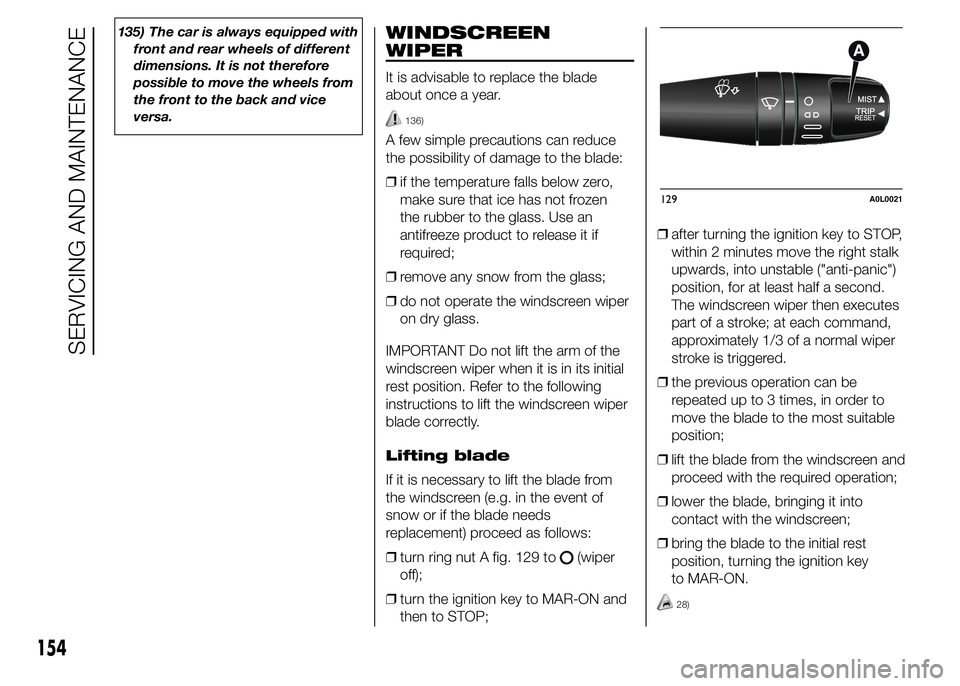
135) The car is always equipped with
front and rear wheels of different
dimensions. It is not therefore
possible to move the wheels from
the front to the back and vice
versa.WINDSCREEN
WIPER
It is advisable to replace the blade
about once a year.
136)
A few simple precautions can reduce
the possibility of damage to the blade:
❒if the temperature falls below zero,
make sure that ice has not frozen
the rubber to the glass. Use an
antifreeze product to release it if
required;
❒remove any snow from the glass;
❒do not operate the windscreen wiper
on dry glass.
IMPORTANT Do not lift the arm of the
windscreen wiper when it is in its initial
rest position. Refer to the following
instructions to lift the windscreen wiper
blade correctly.
Lifting blade
If it is necessary to lift the blade from
the windscreen (e.g. in the event of
snow or if the blade needs
replacement) proceed as follows:
❒turn ring nut A fig. 129 to
(wiper
off);
❒turn the ignition key to MAR-ON and
then to STOP;❒after turning the ignition key to STOP,
within 2 minutes move the right stalk
upwards, into unstable ("anti-panic")
position, for at least half a second.
The windscreen wiper then executes
part of a stroke; at each command,
approximately 1/3 of a normal wiper
stroke is triggered.
❒the previous operation can be
repeated up to 3 times, in order to
move the blade to the most suitable
position;
❒lift the blade from the windscreen and
proceed with the required operation;
❒lower the blade, bringing it into
contact with the windscreen;
❒bring the blade to the initial rest
position, turning the ignition key
to MAR-ON.
28)
129A0L0021
154
SERVICING AND MAINTENANCE
Page 161 of 199
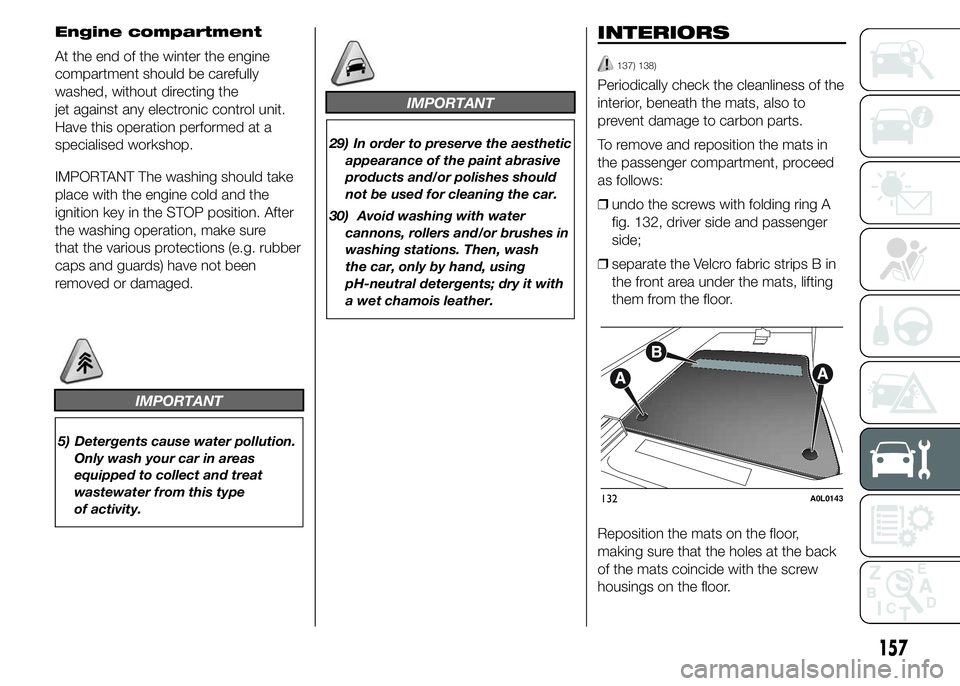
Engine compartment
At the end of the winter the engine
compartment should be carefully
washed, without directing the
jet against any electronic control unit.
Have this operation performed at a
specialised workshop.
IMPORTANT The washing should take
place with the engine cold and the
ignition key in the STOP position. After
the washing operation, make sure
that the various protections (e.g. rubber
caps and guards) have not been
removed or damaged.
IMPORTANT
5) Detergents cause water pollution.
Only wash your car in areas
equipped to collect and treat
wastewater from this type
of activity.
IMPORTANT
29) In order to preserve the aesthetic
appearance of the paint abrasive
products and/or polishes should
not be used for cleaning the car.
30) Avoid washing with water
cannons, rollers and/or brushes in
washing stations. Then, wash
the car, only by hand, using
pH-neutral detergents; dry it with
a wet chamois leather.
INTERIORS
137) 138)
Periodically check the cleanliness of the
interior, beneath the mats, also to
prevent damage to carbon parts.
To remove and reposition the mats in
the passenger compartment, proceed
as follows:
❒undo the screws with folding ring A
fig. 132, driver side and passenger
side;
❒separate the Velcro fabric strips B in
the front area under the mats, lifting
them from the floor.
Reposition the mats on the floor,
making sure that the holes at the back
of the mats coincide with the screw
housings on the floor.
132A0L0143
157
Page 196 of 199
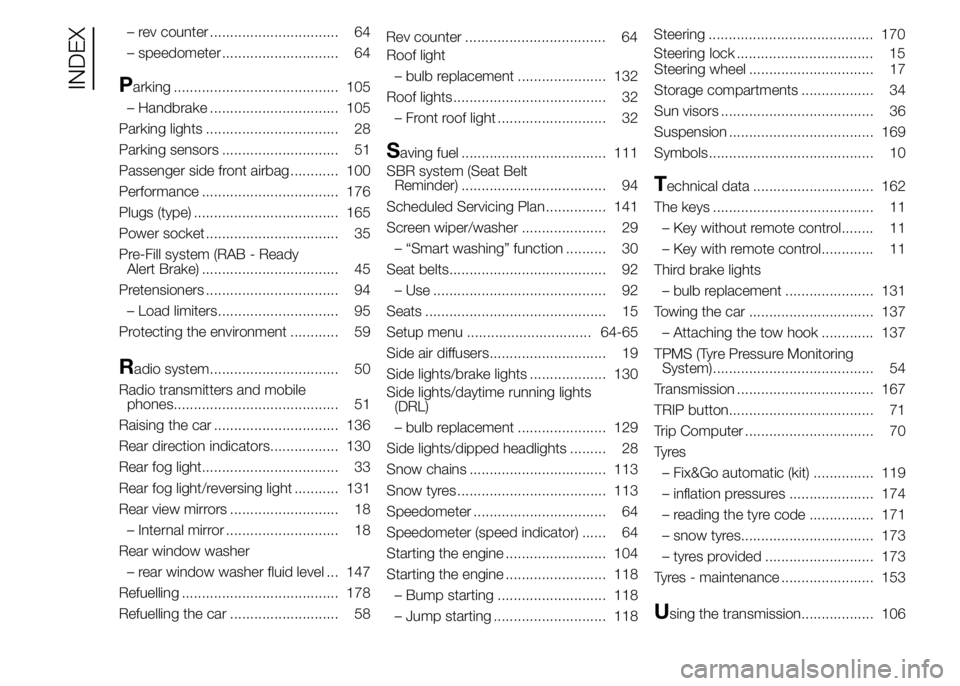
– rev counter ................................ 64
– speedometer ............................. 64
Parking ......................................... 105
– Handbrake ................................ 105
Parking lights ................................. 28
Parking sensors ............................. 51
Passenger side front airbag ............ 100
Performance .................................. 176
Plugs (type) .................................... 165
Power socket ................................. 35
Pre-Fill system (RAB - Ready
Alert Brake) .................................. 45
Pretensioners ................................. 94
– Load limiters.............................. 95
Protecting the environment ............ 59
Radio system................................ 50
Radio transmitters and mobile
phones......................................... 51
Raising the car ............................... 136
Rear direction indicators................. 130
Rear fog light.................................. 33
Rear fog light/reversing light ........... 131
Rear view mirrors ........................... 18
– Internal mirror ............................ 18
Rear window washer
– rear window washer fluid level ... 147
Refuelling ....................................... 178
Refuelling the car ........................... 58Rev counter ................................... 64
Roof light
– bulb replacement ...................... 132
Roof lights...................................... 32
– Front roof light ........................... 32
Saving fuel .................................... 111
SBR system (Seat Belt
Reminder) .................................... 94
Scheduled Servicing Plan ............... 141
Screen wiper/washer ..................... 29
– “Smart washing” function .......... 30
Seat belts....................................... 92
– Use ........................................... 92
Seats ............................................. 15
Setup menu ............................... 64-65
Side air diffusers............................. 19
Side lights/brake lights ................... 130
Side lights/daytime running lights
(DRL)
– bulb replacement ...................... 129
Side lights/dipped headlights ......... 28
Snow chains .................................. 113
Snow tyres ..................................... 113
Speedometer ................................. 64
Speedometer (speed indicator) ...... 64
Starting the engine ......................... 104
Starting the engine ......................... 118
– Bump starting ........................... 118
– Jump starting ............................ 118Steering ......................................... 170
Steering lock .................................. 15
Steering wheel ............................... 17
Storage compartments .................. 34
Sun visors ...................................... 36
Suspension .................................... 169
Symbols......................................... 10
Technical data .............................. 162
The keys ........................................ 11
– Key without remote control........ 11
– Key with remote control............. 11
Third brake lights
– bulb replacement ...................... 131
Towing the car ............................... 137
– Attaching the tow hook ............. 137
TPMS (Tyre Pressure Monitoring
System)........................................ 54
Transmission .................................. 167
TRIP button.................................... 71
Trip Computer ................................ 70
Ty r e s
– Fix&Go automatic (kit) ............... 119
– inflation pressures ..................... 174
– reading the tyre code ................ 171
– snow tyres................................. 173
– tyres provided ........................... 173
Tyres - maintenance ....................... 153
Using the transmission.................. 106
INDEX